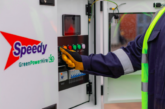A temporary utilities equipment supplier is already reporting huge shifts toward greener fuels following the publication of a National Grid report highlighting rising gas prices due to more depleted storage stocks.
While the National Grid’s Gas Winter Outlook report affirmed that the UK’s gas supplies were sufficient to meet demand, prices would rise due to international market trends putting strain on supply. With the price of fossil fuels rising and fuel shortages continuing, many organisations and construction sites reliant on generator power may face disruption to ongoing operations and projects.
According to Aggreko, this situation, combined with ongoing decarbonisation, have been key factors in surging numbers of its customers switching to hydrotreated vegetable oil (HVO) to power their installations. Specifically, the company has reported HVO rapidly growing from constituting a negligible part of its supplied fuel volume in 2020, to 18% of the total by Q3 2021. This comes following Aggreko’s increased investment in the technology, which can be used as a ‘drop-in’ replacement fuel to power critical equipment while significantly reducing carbon dioxide and other local emissions.
“While issues around fluctuating gas prices have dominated the headlines in recent weeks, it is not the only pressing concern industry faces,” says Chris Rason, Managing Director at Aggreko Northern Europe. “The need to decarbonise in line with net zero targets will continue to be a priority, as shown by the latest National Energy report highlighting further gas supply issues.
“Given these circumstances, and the overwhelming likelihood of sustainability legislation becoming even tighter over time, it is crucial that organisations look into short-to-medium-term steps such as switching to greener fuels. However, we are heartened to see that multiple sectors are meeting this challenge head-on, as shown by the rapidly increasing uptake of HVO fuels from our customers.”
Scientific studies and field trials have shown that HVO can eliminate up to 90% of net carbon dioxide greenhouse gas, while also reducing fine particulate emissions by up to 33%. Alongside this, it can lessen carbon monoxide emissions by 24%, nitrogen oxide by 9% and lower levels of polycyclic aromatic hydrocarbons, or PAH.
Alongside this, HVO’s high cetane number means it is more easily ignited for smoother running, greater power and cleaner performance, meaning it can replace existing fossil fuels without compromising equipment performance. Its viability as a fuel is why Aggreko has committed to cut the amount of diesel used in its fleet by at least 50% by 2030, ahead of achieving carbon neutrality by 2050.
“It cannot be denied that decarbonisation is a daunting prospect, but to make the journey easier, all organisations must identify steps they can immediately take to bridge the gap, such as using HVO,” concludes Chris. “Though many stakeholders may have previously been understandably reticent about the use of these green fuels due to concerns around practicality and performance, technological developments have removed these barriers.
“Indeed, as HVO is distributed, handled and stored in the same way as traditional fuel, and can be stored longer without risk of contamination or spoiling due to cold, these longstanding concerns no longer apply. We believe it is for this reason that we have seen our customers switch to greener fuels at an exponential rate, especially at a time where fossil fuels are becoming increasingly expensive or scarce.”









